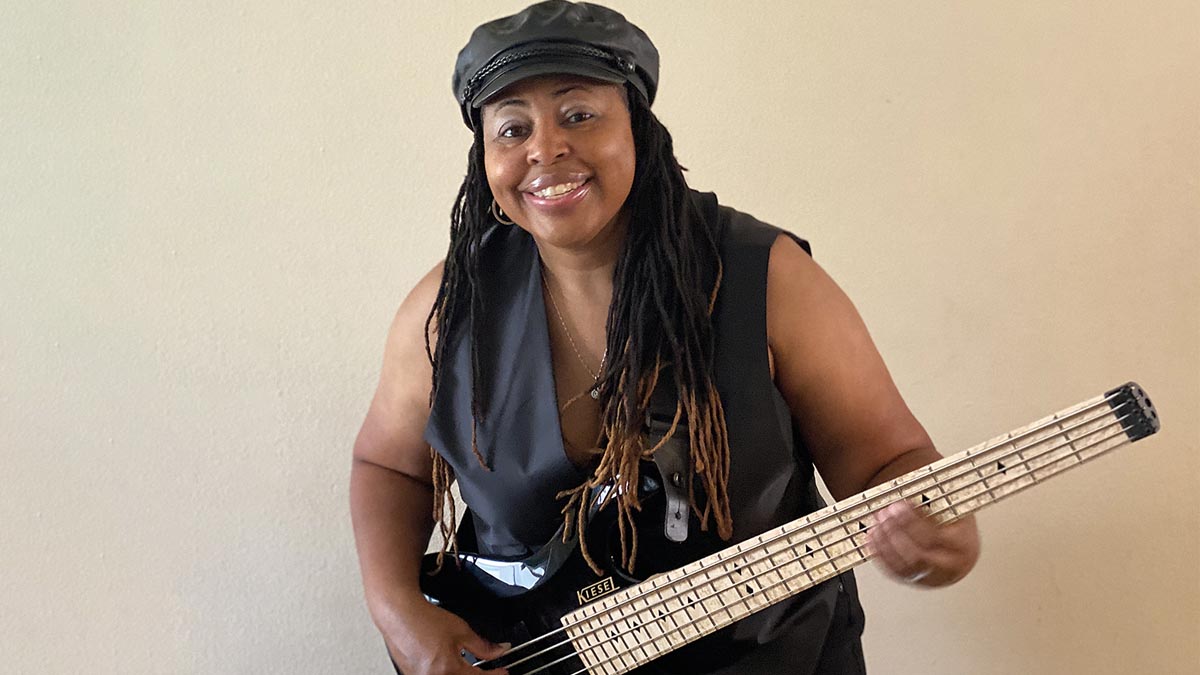Robin Bramlett: “I’ll listen to John Coltrane and transcribe his playing on bass, just so I can think outside of the box”
The gospel bassist reflects on her low-frequency journey

Recording artist, musical director, bassist, songwriter, and producer Robin Bramlett is best known for her roles with the Jazz Is Pink and Hit Like A Girl ensembles, as well as her 2013 solo album, This Is My Life.
A follow-up is on the way, she told us when we caught up with her recently for a discussion about life at the low-end.
Tell us about your bass gear, Robin.
“I’ve been exclusively using Kiesel basses and Aguilar amps for years. I mostly play five-strings, because I need that extra low string – without it I feel lost. I grew up playing gospel, so instead of going from B to G, I tune down from B flat to G flat. I also use MXR effects.”
What's your background as a bass player?
“Well, when I was growing up, we had an upright piano in the house, so that was technically my first instrument, but I soon got interested in watching MTV, where I saw bass guitars, regular guitars, and drums. I was like, ‘Whoa, I want to do all of that!’ so my mom and my dad gave me a toy drum set, a bass guitar and a lead guitar.
“The strings on the lead guitar started breaking because I didn’t want to play with a pick, and then I broke the heads on the toy drum set, and the bass just stayed standing – so I was stuck with that. I think I was around seven years old.”
All the latest guitar news, interviews, lessons, reviews, deals and more, direct to your inbox!
What was that first bass guitar?
“It was some knockoff. I remember it was a black P-Bass with an alder body and a maple fingerboard, but that’s all I remember about it.”
Who were the bass players you admired back then?
“Mark Adams from the funk band Slave, Cedric Martin from Con Funk Shun, Bernard Edwards from Chic, and Marcus Miller. And then later on, when I dived into gospel, my main influences were Joel Smith, Sam Scott, Allen Golden, and Reggie Young.”
Is there a connection within the gospel genre that leads people to identify more deeply with the music, because it’s spiritual in nature?
“That really depends on the person and their spiritual beliefs. They’re going to believe what they believe. If you grew up with gospel, of course you’re going to connect more with it. I think it’s whatever you grew up with that is going to speak more to you. I most definitely connect with gospel, but I also connect with Afro-Cuban music and jazz.”
What do you enjoy about playing gospel?
“For me, gospel music has changed over the years, and to be honest, not for the better. It depends on who it is, though. There’s still some great artists out there that are keeping their urban gospel, like Jonathan Nelson and Chrystal Rucker, but there’s also this big part of gospel that we call Christian Contemporary Music, or CCM, that to me sounds a little bit watered down.
“You know, I’m used to playing different chord changes and interesting runs – I’m used to that. I mean, there’s some CCM tunes I do like, but for the most part, I prefer for gospel to stay interesting, with plenty of unpredictable chord changes.”
What were the inspirations for your album This Is My Life?
“In general, the sounds I grew up listening to. For instance, I actually wrote the song Over The Years in my head as I was driving through my old neighborhood where I started playing bass. The melody and even the chord progression came up in my head as I was driving through the neighborhood. I was like, ‘Whoa, okay, let me write this down before I forget it!’”
Has your bass playing evolved over the years?
“Definitely. I was the musical director for Jazz In Pink for about five years, and I gained skills just from that, you know – writing out charts, preparing music, and making sure everybody was up and running. I also listen to saxophone players. I’ll listen to John Coltrane and transcribe his playing on bass, just so I can think outside of the box and outside of my comfort zone.”
What advice would you give our readers?
“I would say, learn theory, because it will make you a better player – but also, learn to listen to music. Listen to how the bass player is grooving in the music, and emulate that. That’s a big part of what you’re doing. Learn from others and allow yourself to grow, and understand that there’s always someone better than you.”
Bass Player is the world’s most comprehensive, trusted and insightful bass publication for passionate bassists and active musicians of all ages. Whatever your ability, BP has the interviews, reviews and lessons that will make you a better bass player. We go behind the scenes with bass manufacturers, ask a stellar crew of bass players for their advice, and bring you insights into pretty much every style of bass playing that exists, from reggae to jazz to metal and beyond. The gear we review ranges from the affordable to the upmarket and we maximise the opportunity to evolve our playing with the best teachers on the planet.

